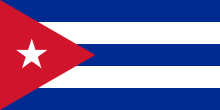CUBA
 Cuba is the largest island of the West Indies and is situated at the entrance of the Gulf of Mexico. Its area is 110 860 sq km with 1250 km from east to west. The island has several small archipelagos : Los Colorados archipelago ; Sábana archipelago ; Camagüey archipelago ; Los Jardínes de la Reina archipelago ; Los Canarreos archipelago (with Juventud Island, before Los Pinos Island). Its plains and fertile valleys are cut by some hills. In the north, the shores are quite Caribbean because of the powdery sand and the turquoise sea. The southern coasts are more wild. In the south-east is Sierra Maestra, the highest range of mountains in the island ; its highest point is Pico Turquino (1972m).
Cuba is the largest island of the West Indies and is situated at the entrance of the Gulf of Mexico. Its area is 110 860 sq km with 1250 km from east to west. The island has several small archipelagos : Los Colorados archipelago ; Sábana archipelago ; Camagüey archipelago ; Los Jardínes de la Reina archipelago ; Los Canarreos archipelago (with Juventud Island, before Los Pinos Island). Its plains and fertile valleys are cut by some hills. In the north, the shores are quite Caribbean because of the powdery sand and the turquoise sea. The southern coasts are more wild. In the south-east is Sierra Maestra, the highest range of mountains in the island ; its highest point is Pico Turquino (1972m).
With regard to the flora, there are 90 species of palm, for example the royal palm which is the national tree. Since 1959, the reforestation is very important for the government : 3 million trees were planted. Almost 15% of the territory is protected by six national parks namely : Parque nacional Desembarco del Granmá ; Gran Parque nacional Sierra Maestra ; Gran Parque natural Montemar ; Parque nacional Alejandro de Humbolt ; Parque nacional Peninsula de Guanahacabibes ; Parque nacional Viñales.
Concerning the wildlife, Cuba shelters 350 species of bird in particular tne national bird, the tocororo or trogon bird, a native species whose plumage resembles Cuban flag colors. However, if many native animals have been exterminated, the “ranita de Cuba” (the world’s smallest toad with its 1cm) and the “jutía” (a big tree rat with its 4kg) have survived. With almost 6000 km of coastline, Cuba’s coral reef houses more than 900 species of fish, 400 species of sponge, turtles etc.
Cuba produces nickel, sugar, citrus fruit, tabacco, rice… The province of Pinar del Río is, in fact, like Cuba’s garden. Since the thaw of its relations with the United States of American, Cuba is about to become an important tourist destination in the Caribbean. At the end of the 1st half-year of 2016, 2 147 600 tourists visited the island, according to the Ministry of Tourism.
Cuba was discovered on October 27, 1492 by Christopher Columbus. At that time, the Arawak Indians lived in the island. Between 1511 and 1514, Diego Velásquez de Cuéllar and his troops of Spanish conquistadores fought against the Amerindians and their leaders – Hatuey and Granmá – to conquer this land. Bad treatments and deseases wiped out the Arawaks. At the time of the landing, they were 120 000 people, in 1550, they were about 5 000.
From the 16th century, Spain transported to the island thousands of African slaves to grow coffee, sugar cane and tabacco. The first settlement was founded in Baracoa in 1512 by Velásquez and served as the capital. Santiago de Cuba was created in 1514 to be Cuba’s first capital from 1515 to 1607, then Havana took its place.
By the 1820s, Cuba became the world’s largest sugar producer. The United States of America offered twice to buy Cuba from Spain. Slaves trade developed so, by the 1840s, there were in Cuba 400 000 Africans.
From October 1868 to February 1878, Cuba’s first War of Independence broke out. In 1880, slavery was abolished. The nationalist leader, the poet José Martí, organized the revolution in April 1895 but he was killed on May 19 in the same year.
On July 1, 1898, US army led by the future President Theodore Roosevelt attacked Spanish troops who surrendered two weeks later.
In 1901, Cuba became an independent State. Two years later, the Americans used the amendment decided after the Spanish-American War to build a naval base in Guantánamo. The island was led by corrupt governments. Fidel Castro with his “guerrilleros” (among them, Ernesto “Che” Guevara, Camilo Cienfuegos and his brother Raúl) attacked and overthrew Fulgencio Batista’s dictature. On January 1959, Castro entered triumphantly Santiago de Cuba. He abolished property, racial discrimination and nationalized American companies. In 1961, USA replied by an trade embargo. Cuba came very close to USSR. Between 1959 and 1970, 500 000 Cubans left the country and most of them took refuge in Florida.
From 1961 to 1962, the island was an area of tension between Soviets and Americans after the failure of the anti-Castro landing in the Bay of Pigs. On October 1962, USSR gave up the idea of installing missiles in Cuba pointed at the United States.
Since 2006, Fidel Castro left Cuba’s Presidence to Raúl Castro.
In 2015, USA President, Barak Obama and Cuba’s new President, Raúl Castro have started a reconciliation between both countries. On March 20, 2016, Barack Obama visited Cuba, there were 88 years an American leader did not come to this Caribbean island.
Area : 110 860 sq km (42 803 sq miles)
Population : 11,2 million inhabitants
Capital : Havana
Language : Spanish
Currencies : Cuban Peso (CUP) – Cuban Peso Convertible (CUC)
People : Cubans
